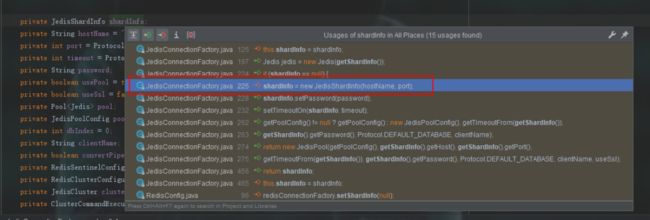从源码研究如何不重启Springboot项目实现redis配置动态切换
上一篇Websocket的续篇暂时还没有动手写,这篇算是插播吧。今天讲讲不重启项目动态切换redis服务。
背景
多个项目或微服务场景下,各个项目都需要配置redis数据源。但是,每当运维搞事时(修改redis服务地址或端口),各个项目都需要进行重启才能连接上最新的redis配置。服务一多,修改各个项目配置然后重启项目就非常蛋疼。所以我们想要找到一个可行的解决方案,能够不重启项目的情况下,修改配置,动态切换redis服务。
如何实现切换redis连接
刚遇到这个问题的时候,想必如果对spring-boot-starter-data-redis不是很熟悉的人,首先想到的就是去百度一下(安慰下自己:不要重复造轮子嘛)。
可是一阵百度之后,你找到的结果可能都是这样的:
public ValueOperations updateRedisConfig() {
JedisConnectionFactory jedisConnectionFactory = (JedisConnectionFactory) stringRedisTemplate.getConnectionFactory();
jedisConnectionFactory.setDatabase(db);
stringRedisTemplate.setConnectionFactory(jedisConnectionFactory);
ValueOperations valueOperations = stringRedisTemplate.opsForValue();
return ValueOperations;
}没错,绝大多数都是切换redis db的代码,而没有切redis服务地址或账号密码的。而且天下代码一大抄,大多数博客都是一样的内容,这就让人很恶心。
没办法,网上没有,只能自己造轮子了。不过,从强哥这种懒人思维来说,上面的代码既然能切库,那是不是host、username、password也同样可以,于是我们加入如下代码:
public ValueOperations updateRedisConfig() {
JedisConnectionFactory jedisConnectionFactory = (JedisConnectionFactory) stringRedisTemplate.getConnectionFactory();
jedisConnectionFactory.setDatabase(db);
jedisConnectionFactory.setHostName(host);
jedisConnectionFactory.setPort(port);
jedisConnectionFactory.setPassword(password);
stringRedisTemplate.setConnectionFactory(jedisConnectionFactory);
ValueOperations valueOperations = stringRedisTemplate.opsForValue();
return valueOperations;
}话不多说,改完重启一下。额,运行结果并没有让我们见证奇迹的时刻。在调用updateRedisConfig方法的之后,使用redisTemplate还是只能切换db,不能进行服务地址或账号密码的更新。
这就让人头疼了,不过想也没错,如果可以的话,网上不应该找不到类似的代码。那么,现在该咋办嘞?
强哥的想法是:redisTemplate每次获取ValueOperations执行get/set方法的时候,都会去连接redis服务器,那么我们就从这两个方法入手看看能不能找得到解决方案。
接下来就是源码研究的过程啦,有耐心的小伙伴就跟着强哥一起找,只想要结果的就跳到文末吧~
首先来看看入手工具方法set:
public boolean set(final String key, Object value) {
boolean result = false;
try {
ValueOperations operations = redisTemplate.opsForValue();
operations.set(key, value);
result = true;
} catch (Exception e) {
logger.error("set cache error:", e);
}
return result;
} 我们进入到operations.set(key, value);的set方法实现:
public boolean set(String key, Object value) {
boolean result = false;
try {
ValueOperations operations = this.redisTemplate.opsForValue();
operations.set(key, value);
result = true;
} catch (Exception var5) {
this.logger.error("set error:", var5);
}
return result;
} 哦,走的是execute方法,进去看看,具体调用的是AbstractOperations的RedisTemplate的execute方法(中间跳过几个重载方法跳转):
public T execute(RedisCallback action, boolean exposeConnection, boolean pipeline) {
Assert.isTrue(initialized, "template not initialized; call afterPropertiesSet() before using it");
Assert.notNull(action, "Callback object must not be null");
RedisConnectionFactory factory = getConnectionFactory();
RedisConnection conn = null;
try {
if (enableTransactionSupport) {
// only bind resources in case of potential transaction synchronization
conn = RedisConnectionUtils.bindConnection(factory, enableTransactionSupport);
} else {
conn = RedisConnectionUtils.getConnection(factory);
}
boolean existingConnection = TransactionSynchronizationManager.hasResource(factory);
RedisConnection connToUse = preProcessConnection(conn, existingConnection);
boolean pipelineStatus = connToUse.isPipelined();
if (pipeline && !pipelineStatus) {
connToUse.openPipeline();
}
RedisConnection connToExpose = (exposeConnection ? connToUse : createRedisConnectionProxy(connToUse));
T result = action.doInRedis(connToExpose);
// close pipeline
if (pipeline && !pipelineStatus) {
connToUse.closePipeline();
}
// TODO: any other connection processing?
return postProcessResult(result, connToUse, existingConnection);
} finally {
RedisConnectionUtils.releaseConnection(conn, factory);
}
} 方法内容很长,不过大致可以看出前面是获取一个RedisConnection对象,后面应该就是命令的执行,为什么说应该?因为强哥也没去细看后面的实现,因为我们要关注的就是怎么拿到这个RedisConnection对象的。
那么我们走RedisConnectionUtils.getConnection(factory);这句代码进去看看,为什么我知道是走这句而不是上面那句,因为强哥没开事务,如果大家有打断点,应该默认也是走的这句,跳到具体的实现方法:RedisConnectionUtils.doGetConnection(……):
public static RedisConnection doGetConnection(RedisConnectionFactory factory, boolean allowCreate, boolean bind,
boolean enableTransactionSupport) {
Assert.notNull(factory, "No RedisConnectionFactory specified");
RedisConnectionHolder connHolder = (RedisConnectionHolder) TransactionSynchronizationManager.getResource(factory);
if (connHolder != null) {
if (enableTransactionSupport) {
potentiallyRegisterTransactionSynchronisation(connHolder, factory);
}
return connHolder.getConnection();
}
if (!allowCreate) {
throw new IllegalArgumentException("No connection found and allowCreate = false");
}
if (log.isDebugEnabled()) {
log.debug("Opening RedisConnection");
}
RedisConnection conn = factory.getConnection();
if (bind) {
RedisConnection connectionToBind = conn;
if (enableTransactionSupport && isActualNonReadonlyTransactionActive()) {
connectionToBind = createConnectionProxy(conn, factory);
}
connHolder = new RedisConnectionHolder(connectionToBind);
TransactionSynchronizationManager.bindResource(factory, connHolder);
if (enableTransactionSupport) {
potentiallyRegisterTransactionSynchronisation(connHolder, factory);
}
return connHolder.getConnection();
}
return conn;
}代码还是很长,话不多说,断点走的这句:RedisConnection conn = factory.getConnection();那就看看其实现方法吧:JedisConnectionFactory.getConnection(),这个是个关键方法:
public RedisConnection getConnection() {
if (cluster != null) {
return getClusterConnection();
}
Jedis jedis = fetchJedisConnector();
JedisConnection connection = (usePool ? new JedisConnection(jedis, pool, dbIndex, clientName)
: new JedisConnection(jedis, null, dbIndex, clientName));
connection.setConvertPipelineAndTxResults(convertPipelineAndTxResults);
return postProcessConnection(connection);
}看到了,代码很短,但是我们从中可以获取到的内容却很多:
-
第一个判断是是否有集群,这个强哥项目暂时没用,所以不管;如果大家有用到,可能要要考虑下里面的代码。
-
Jedis对象是在这里创建的,熟悉redis的应该都知道:Jedis是Redis官方推荐的Java连接开发工具。直接用它就能执行redis命令。
-
usePool 这个变量,说明我们连接的redis服务器的时候可能用到了连接池;不知道大家看到usePool会不会有种恍然醒悟的感觉,很可能就是因为我们使用了连接池,所以即使我们之前的代码中切换了账号密码,连接池的连接还是没有更新导致的处理无效。
我们先看看fetchJedisConnector方法实现:
protected Jedis fetchJedisConnector() {
try {
if (usePool && pool != null) {
return pool.getResource();
}
Jedis jedis = new Jedis(getShardInfo());
// force initialization (see Jedis issue #82)
jedis.connect();
potentiallySetClientName(jedis);
return jedis;
} catch (Exception ex) {
throw new RedisConnectionFailureException("Cannot get Jedis connection", ex);
}
}哦,可以看到,Jedis对象是根据getShardInfo()构建出来的:
public BinaryJedis(JedisShardInfo shardInfo) {
this.client = new Client(shardInfo.getHost(), shardInfo.getPort(), shardInfo.getSsl(), shardInfo.getSslSocketFactory(), shardInfo.getSslParameters(), shardInfo.getHostnameVerifier());
this.client.setConnectionTimeout(shardInfo.getConnectionTimeout());
this.client.setSoTimeout(shardInfo.getSoTimeout());
this.client.setPassword(shardInfo.getPassword());
this.client.setDb((long)shardInfo.getDb());
}那就是说,只要我们掌握了这个JedisShardInfo的由来,我们就可以实现redis相关配置的切换。而这个getShardInfo()方法就是返回了JedisConnetcionFactory类的JedisShardInfo shardInfo属性:
public JedisShardInfo getShardInfo() {
return shardInfo;
}那么如果我们知道了这个shardInfo是如何创建的,是不是就可以干预到RedisConnect的创建了呢?我们来找找它被创建的地方:
走的JedisConnectionFactory的afterPropertiesSet()进去看看:
/*
* (non-Javadoc)
* @see org.springframework.beans.factory.InitializingBean#afterPropertiesSet()
*/
public void afterPropertiesSet() {
if (shardInfo == null) {
shardInfo = new JedisShardInfo(hostName, port);
if (StringUtils.hasLength(password)) {
shardInfo.setPassword(password);
}
if (timeout > 0) {
setTimeoutOn(shardInfo, timeout);
}
}
if (usePool && clusterConfig == null) {
this.pool = createPool();
}
if (clusterConfig != null) {
this.cluster = createCluster();
}
}哦吼~,整篇博文最关键的代码终于出现了。我们可以看到,JedisShardInfo的所有信息都是从JedisConnetionFactory的属性中来的,包括hostName、port、password、timeout等。而且,如果JedisShardInfo为null时,调用afterPropertiesSet方法会帮我们创建出来。然后,该方法还会帮我们创建新的连接池,简直完美。最最重要的是,这个方法是public的。
所以,嘿嘿,综上,我们总结改造的几个点:
-
连接redis用到了连接池,需要先给他销毁;
-
创建Jedis的时候,将JedisShardInfo先设为null;
-
手动设置JedisConnetionFactory的hostName、port、password等信息;
-
调用JedisConnetionFactory的afterPropertiesSet方法创建JedisShardInfo;
-
给RedisTemplate设置处理后的JedisConnetionFactory,这样在下次使用set或get方法的时候就会去创建新改配置的连接池啦。
实现如下:
public void updateRedisConfig() {
RedisTemplate template = (RedisTemplate) applicationContext.getBean("redisTemplate");
JedisConnectionFactory redisConnectionFactory = (JedisConnectionFactory) template.getConnectionFactory();
//关闭连接池
redisConnectionFactory.destroy();
redisConnectionFactory.setShardInfo(null);
redisConnectionFactory.setHostName(host);
redisConnectionFactory.setPort(port);
redisConnectionFactory.setPassword(password);
redisConnectionFactory.setDatabase(database);
//重新创建连接池
redisConnectionFactory.afterPropertiesSet();
template.setConnectionFactory(redisConnectionFactory);
}
重启项目之后,调用这个方法,就可以实现redis库及服务地址、账号密码的切换而无需重启项目了。
如何实现动态切换
强哥这里就使用同一配置中心Apollo来进行动态配置的。
首先不懂Apollo是什么的同学,先Apollo官网半日游吧(直接看官网教程,比看其他博客强)。简单的说就是一个统一配置中心,将原来配置在项目本地的配置(如:Spring中的application.properties)迁移到Apollo上,实现统一的管理。
使用Apollo的原因,其实就是因为其接入简单,且具有实时更新回调的功能,我们可以监听Apollo上的配置修改,实现针对修改的配置内容进行相应的回调监听处理。
因此我们可以将redis的配置信息配置在Apollo上,然后监听这些配置。当Apollo上的这些配置修改时,我们在ConfigChangeListener中,调用上面的updateRedisConfig方法就可以实现redis配置的动态切换了。
接入Apollo代码非常简单:
Config redisConfig = ConfigService.getConfig("redis");
ConfigChangeListener listener = this::updateRedisConfig;
redisConfig.addChangeListener(listener);
这样,我们就可以实现具体所谓的动态更新配置啦~
当然,其他有相同功能的配置中心其实也可以,只是强哥项目中暂时用的就是Apollo就拿Apollo来讲了。
考虑到篇幅已经很长了,就不多解释Apollo的使用了,用过的自然看得懂上面的方法,有不懂的也可以留言提问哦。
好了,就到这吧,原创不易,怎么支持你们知道~,那么下次见啦~
关注公众号获取更多内容,有问题也可在公众号提问哦:
![]()
强哥叨逼叨
叨逼叨编程、互联网的见解和新鲜事
